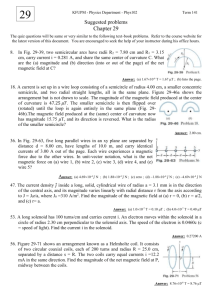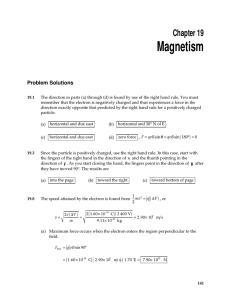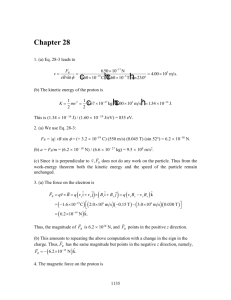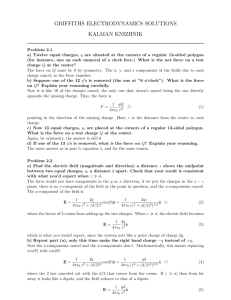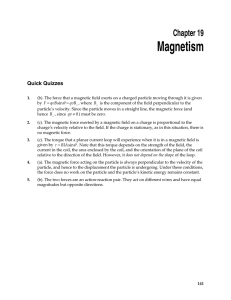Exam 4: Problems and Solutions
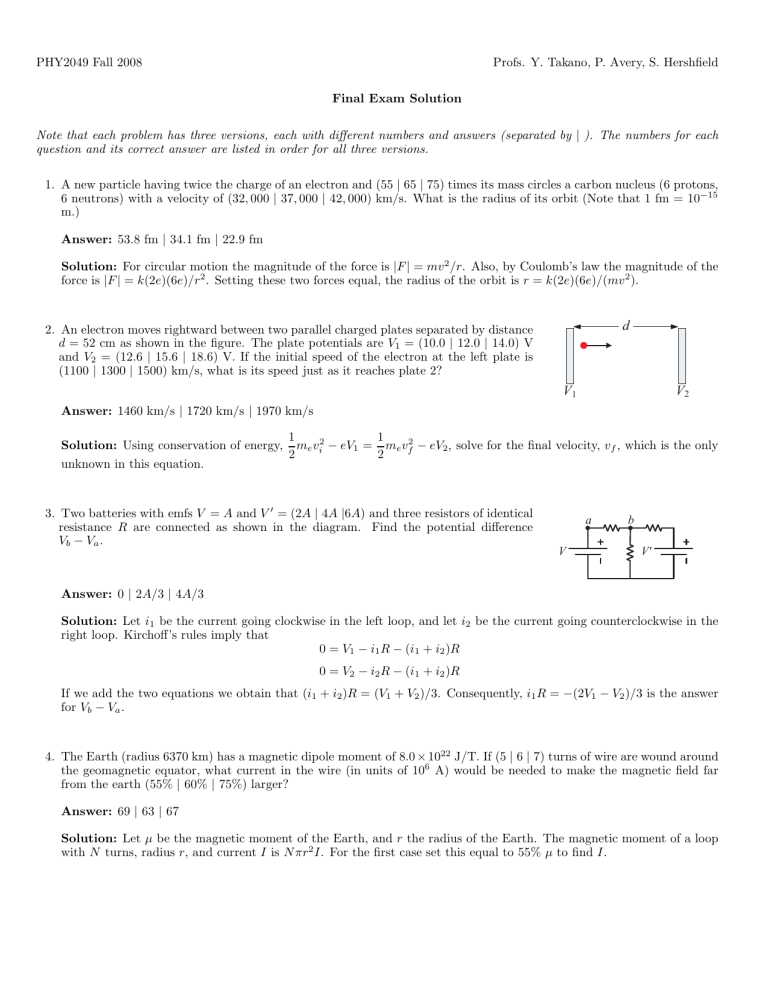
PHY2049 Fall 2008 Profs. Y. Takano, P. Avery, S. Hershfield
Final Exam Solution
Note that each problem has three versions, each with different numbers and answers (separated by | ). The numbers for each question and its correct answer are listed in order for all three versions.
1. A new particle having twice the charge of an electron and (55 | 65 | 75) times its mass circles a carbon nucleus (6 protons,
6 neutrons) with a velocity of (32 , 000 | 37 , 000 | 42 , 000) km/s. What is the radius of its orbit (Note that 1 fm = 10 m.)
− 15
Answer: 53.8 fm | 34.1 fm | 22.9 fm
Solution: For circular motion the magnitude of the force is force is | F | = k (2 e )(6 e ) /r 2
| F | = mv 2 /r . Also, by Coulomb’s law the magnitude of the
. Setting these two forces equal, the radius of the orbit is r = k (2 e )(6 e ) / ( mv 2 ).
2. An electron moves rightward between two parallel charged plates separated by distance d = 52 cm as shown in the figure. The plate potentials are V
1
= (10 .
0 | 12 .
0 | 14 .
0) V and V
2
= (12 .
6 | 15 .
6 | 18 .
6) V. If the initial speed of the electron at the left plate is
(1100 | 1300 | 1500) km/s, what is its speed just as it reaches plate 2?
d
V
1
V
2
Answer: 1460 km/s | 1720 km/s | 1970 km/s
Solution: Using conservation of energy,
1
2 m e v i
2 − eV
1
=
1
2 m e v 2 f
− eV
2
, solve for the final velocity, v f
, which is the only unknown in this equation.
3. Two batteries with emfs V = A and V ′ = (2 A | 4 A | 6 A ) and three resistors of identical resistance R are connected as shown in the diagram. Find the potential difference
V b
− V a
.
V a b
V'
Answer: 0 | 2 A/ 3 | 4 A/ 3
Solution: Let i
1 be the current going clockwise in the left loop, and let right loop. Kirchoff’s rules imply that i
2
0 = V
1
− i
1
R − ( i
1
+ i
2
) R be the current going counterclockwise in the
0 = V
2
− i
2
R − ( i
1
+ i
2
) R
If we add the two equations we obtain that ( i
1
+ i
2
) R = ( V
1
+ V
2
) / 3. Consequently, i
1
R = − (2 V
1
− V
2
) / 3 is the answer for V b
− V a
.
4. The Earth (radius 6370 km) has a magnetic dipole moment of 8 .
0 × 10 22 the geomagnetic equator, what current in the wire (in units of 10 6
J/T. If (5 | 6 | 7) turns of wire are wound around
A) would be needed to make the magnetic field far from the earth (55% | 60% | 75%) larger?
Answer: 69 | 63 | 67
Solution: Let µ be the magnetic moment of the Earth, and r the radius of the Earth. The magnetic moment of a loop with N turns, radius r , and current I is N πr 2 I . For the first case set this equal to 55% µ to find I .
5. As shown in the figure, two radio towers are spaced a distance of (18 | 21 | 24) m apart and radiating at a wavelength of (4.3
| 4.5
| 4.7) m. Tower 2 radiates at the same intensity as tower 1 but (38 ◦ | 48 ◦ | 58 ◦ ) later in phase. If a radio receiver is placed a long distance away, what is the smallest angle θ at which the intensity of the combined signal is a relative minimum?
1
θ
2
Answer: 5 .
4 ◦ | 4 .
5 ◦ | 3 .
8 ◦
Solution: The net phase difference between the two sources is
38 ◦
φ
2
− φ
1
= 2 π
360 ◦
+ 2 π d sin θ
λ
.
For destructive interference the phase difference is an odd multiple of π . The smallest θ will come from π , which implies that sin θ =
λ 1 38 a 2
−
360
.
6. A diffraction grating of width W produces a (third | fourth | fifth)-order pattern at angle θ for light of wavelength λ . The total number of slits in the grating must be
Answer: ( W/ 3 λ ) sin θ | ( W/ 4 λ ) sin θ | ( W/ 5 λ ) sin θ
Solution: For a diffraction grating the condition for the m order maximum is d sin θ = mλ , where d is the slit separaration.
The total number of slits is W/d = ( W/mλ ) sin θ .
7. A consortium (www.tmt.org) plans to build a 30-meter diameter telescope having unprecedented light collection capability and angular resolution. If the angular resolution is limited by diffraction, what is the approximate maximum distance in light years (1 light year = 9 .
5 × 10 12 km) that the telescope can distinguish two stars separated by the earth-sun distance of 1 .
5 × 10 8 km? Assume that the observation takes place using (1100 | 1300 | 1500) nm infrared light.
Answer: 350 | 300 | 260
Solution: The Rayleigh criterion for resolution of two distant objects is ∆ θ = 1 .
22 λ/D . The Earth-Sun separation at a distance of x light years away extends an angle ∆ θ = (1 .
5 × 10 11 m ) / ( x 9 .
5 × 10 15 m ). Solve for x .
8. A wire (50 | 70 | 90) cm long carries a (0.4
| 0.6
| 0.7) A current along the + x axis through a magnetic field
What is the magnitude of the magnetic force on the wire in newtons?
~
= (4.0 mT)ˆ +(5.0 mT)ˆ .
Answer: 1 .
3 × 10 −
3 | 2 .
7 × 10 −
3 | 4 .
0 × 10 −
3
Solution: The current flow is perpendicular to the magnetic field so the magnitude of the force is just F = iL | B | , where the magnitude of the magnetic field in this case is (4 2 + 5 2 ) 1 / 2 mT.
9. In the circuit shown, E = 1 .
5 | 3 .
0 | 2 .
0 V, R
1
= 3 .
0 | 2 .
0 | 1 .
0 Ω, R
2
= 2 .
0 | 5 .
0 | 3 .
0 Ω, and L = 1 .
0 H. A long time after the switch is closed, it is reopened. Just after reopening, what is the current through R
2
?
E
R
1
R
2
L
Answer: 0.50 A | 1.5 A | 2.0 A
Solution: A long time after the switch is closed, the current is not changing and hence the voltage across the inductor is zero. Since R
2 is in parallel with L , the voltage across R
2 is also zero. The current in the circuit is E /R
1
. The current flows through R
1 and then through L . Immediately after the switch is reopened the current through the inductor can not change instantaneously so it is still E /R
1
. This current flows through the inductor and then up through R
2
.
10. The average intensity of light shining on a desk surface is (300 | 600 | 100) mW/m 2 . Assuming that the light is in the form of an electromagnetic plane wave, what is the maximum electric-field amplitude?
Answer: 15 V/m | 21 V/m | 8.7 V/m
Solution: The intensity of the light in terms of the maximum electric field is I = E 2 m
/ (2 cµ o
).
11. An object is placed in front of a spherical mirror at a distance of (3 .
0 | 4 .
0 | 2 .
0) m. The image has the same orientation as the object, with a height (30% | 55% | 70%) of that of the object. Which description of the mirror is correct?
Answer: convex, with a focal length of (1 .
3 | 4 .
9 | 4 .
7) m
Solution: In the first case the magnification is m = 0 .
3 = − i/p . Since p is 3, i is − 0 .
9. This allows one to find f = 1 .
3 using 1 /p + 1 /i = 1 /f .
12. In the figure shown (not to scale), the focal lengths of the thin converging lenses,
L1 and L2, are 20 cm and (10 | 15 | 13) cm, respectively. When object O is placed
30 cm to the left of L1, its image forms at (7 | 8 | 9) cm to the right of L2. What is the distance between the two lenses in cm?
O
L1 L2
Answer: 37 | 43 | 31
Solution: Again using the numbers for the first case, first find the image distance for L1.
1
30
+
1 i
1
=
1
20
→ i
1
= 60 cm
Next find the object distance for L2.
1 p
2
+
1
7
=
1
10
→ p
2
= − 23 .
33 cm
Because p
2 is negative, it is to the right of L2. Since the image from L1 and the object from L2 are the same, the separation between the lenses is 60 − 23 .
33 ≈ 37 cm.
13. Which of the following statements is true?
Answer: All images formed by a diverging lens are virtual, as are all images formed by a convex mirror.
Solution: For a single lens or mirror, p is positive. Consequently, if the focal length is negative, the image distance must be negative because 1 /i = 1 /f − 1 /p .
14. A thin film of kerosene ( n = 1 .
20) covers the surface of water ( n = 1 .
30). A beam of light ( λ = (400 | 550 | 630) nm), perpendicular to it, illuminates the surface. What is the minimum film thickness (in nm) that gives the brightest reflection because of constructive interference?
Answer: 167 | 229 | 263
Solution: There are additional phase shifts of π when going from n = 1 to n = 1 .
20 and when going from n = 1 .
20 to n = 1 .
30; however, the relative phase shift for interference is unchanged. The condition for constructive interference is
2 d = m ( λ/ 1 .
20). The smallest d occurs when m = 1.
15. In an L-C circuit the maximum voltage across the capacitor is 3 V. If L = 50 | 40 | 30 mH and C = 6 | 8 | 9 µ F, what is the maximum current in the circuit?
Answer: 33 mA | 42 mA | 52 mA
Solution: The maximum current is 3 V /X
C
, where X
C
= 1 /ωC and ω = 1 /
√
LC .
16. A thin converging lens has focal length 8 cm. An object of height (3 | 2 | 4) cm is placed 12 cm away from the lens. What is the height of the resulting image, and is the image inverted or noninverted?
Answer: (6 | 4 | 8) cm inverted
Solution: Using the numbers for the first case, the image distance is (1 / 8 − 1 / 12) − 1 = 24 cm. Hence, the magnification is m = − i/p = − 2. If the object has height 3 cm, then the image will have height 6 cm and be inverted ( m < 0). Since the numerical answers above were not in the choices on the exam, everyone was given credit for this problem.
17. Three capacitors, C
1
= 2 µ F, C
2
= 4 µ F, and C
3
= 6 | 8 | 10 µ F, are placed in series. If the charge on capacitor C
1 is
2 µ C, what is the voltage across capacitor C
3
?
Answer: (0 .
33 | 0 .
25 | 0 .
20) V
Solution: For capacitors in series the charge is the same. Hence, the charge on C
3 is also Q
1
, and the voltage across C
3 is V
3
= Q
1
/C
3
. Since the numerical answers above were not in the choices on the exam, everyone was given credit for this problem.
18. In the figure the wire carries current (2 | 3 | 4) A, and the loop carries current (3 | 2 | 3)
A in the indicated directions. The radius of the loop is 2 mm. What is the magnitude of the magnetic field at the center of the loop?
Answer: 0.74 mT | 0.33 mT | 0.54 mT
Solution: As show in the figure the wire produces a magnetic field going out of the page at the center of the loop, and the loop produces a magnetic field going into the page. The magnitude of the magnetic field is
| B | = |
µ o i
W
2 πr
−
µ o i
L
2 r
| , where i
W is the current in the wire and i
L is the current in the loop.
19. A slit 1.00 mm wide is illuminated by light of wavelength 450 nm. We see a diffraction pattern on a screen (2.00
| 4.00
| 3.00) m away. What is the distance between the first two diffraction minima on the same side of the central diffraction maximum?
Answer: 0.90 mm | 1.80 mm | 1.35 mm
Solution: The condition for a diffraction minimum is a sin θ = mλ . The two closest minima to the central maximum are m = 1 and m = 2. Because θ is small sin θ ≈ θ in radians. The position on the wall is L tan θ ≈ Lθ , where L is the distance to the screen. Putting these together, Lθ
2
− Lθ
1
= Lλ/a .
20. If mirror M
2 in the Michelson interferometer at right is moved through 0.300 mm, a shift of (900 | 800 | 1200) bright fringes occurs. What is the wavelength of the light producing the fringe pattern?
Answer: 667 nm | 750 nm | 500 nm
Solution: One shift of fringes occurs for every change in the path length of λ . Consequently, a shift of 900 fringes corresponds to a change in the path length of 900 λ . For an interferometer the path length difference is 2 L
2
− 2 L
1 so
2∆ L
2
= 900 λ .






